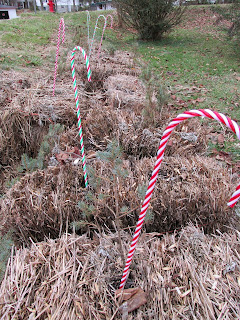Last night I hosted 12 people for a Christmas party and dinner. I love planning, cooking and hosting when I have time to enjoy it, which I did. Plus, it’s easy to put it in the time and energy for a group of people you love.
Last night’s gathering was for a writer’s group that I’ve
been part of for 11 years. We first met in a local writing class that I taught.
Since then, members of the group have published multiple times in all forms of
media. It’s amazing to see what everyone has done through the years.
I wanted to take some of the load off them during this
season so I offered to prepare our entire celebration for this Christmas
season. Most of what we ate came from our garden or from other local sources.
Here’s the menu, which turned out so well that I would replicate it again:
Appetizers
Cheeseball and crackers—Mom’s women’s group sells the
cheeseballs every year, so this is always a given for my holiday get-togethers.
Spiced nuts—I found this recipe in O Magazine. It’s the first time I made spiced nuts. Next time I’ll cook them for a slightly shorter period of time since they almost burned.
Spiced nuts—I found this recipe in O Magazine. It’s the first time I made spiced nuts. Next time I’ll cook them for a slightly shorter period of time since they almost burned.
Meal
Lettuce and Spinach salad—I wish I could say it was from my
garden!
Fagottini di pollo—Also known as Chicken Bundles. This is a recipe from Lidia Bastianich and you can’t go wrong with it. I used our canned tomatoes for the sauce.
Green beans and purple potatoes—Both from our garden. Potatoes will keep for months in a cool, dark place.
Sweet potatoes and apples—Yes, I used our sweet potatoes. The apples came from Reed Valley, an area orchard that I like.
Winter squash risotto—This is the easiest risotto recipe because you bake it instead of constantly stirring on top of the stove. I used our home pureed pumpkin and one of our remaining butternut squashes. Winter squashes will also keep for a good amount of time inside at a cool temperature in a dark place if they are cured first.
Fagottini di pollo—Also known as Chicken Bundles. This is a recipe from Lidia Bastianich and you can’t go wrong with it. I used our canned tomatoes for the sauce.
Green beans and purple potatoes—Both from our garden. Potatoes will keep for months in a cool, dark place.
Sweet potatoes and apples—Yes, I used our sweet potatoes. The apples came from Reed Valley, an area orchard that I like.
Winter squash risotto—This is the easiest risotto recipe because you bake it instead of constantly stirring on top of the stove. I used our home pureed pumpkin and one of our remaining butternut squashes. Winter squashes will also keep for a good amount of time inside at a cool temperature in a dark place if they are cured first.
Dessert
Pawpaw Sour Cream Pie—This was from the pawpaws we collected
in September and pureed. It’s a little piece of heaven.
Chocolate Bark—I also found this recipe in O Magazine. I made it with dark chocolate and didn’t entirely cover the cracker with chocolate because I liked the contrasting color.
Various other cookies and candies
Chocolate Bark—I also found this recipe in O Magazine. I made it with dark chocolate and didn’t entirely cover the cracker with chocolate because I liked the contrasting color.
Various other cookies and candies
Yes, it was a feast. Yes, I slept well after the fun and the
relaxation following a good meal. Yes, I’ll do it again.
Before I go, I must apologize for forgetting to take
pictures of the food. I was having so much fun that I forgot to pick up the
camera. However, this afternoon I did get a photo of my Charlie Brown Christmas
Village that I wrote about last week. You'll have to look hard to see the little trees. I had hoped we would get snow to liven it
up, but until then, this is what greets our visitors.
Merry Christmas to you all!



